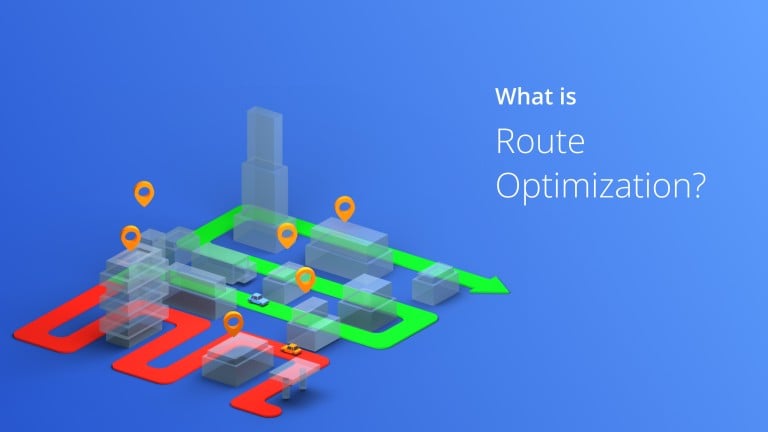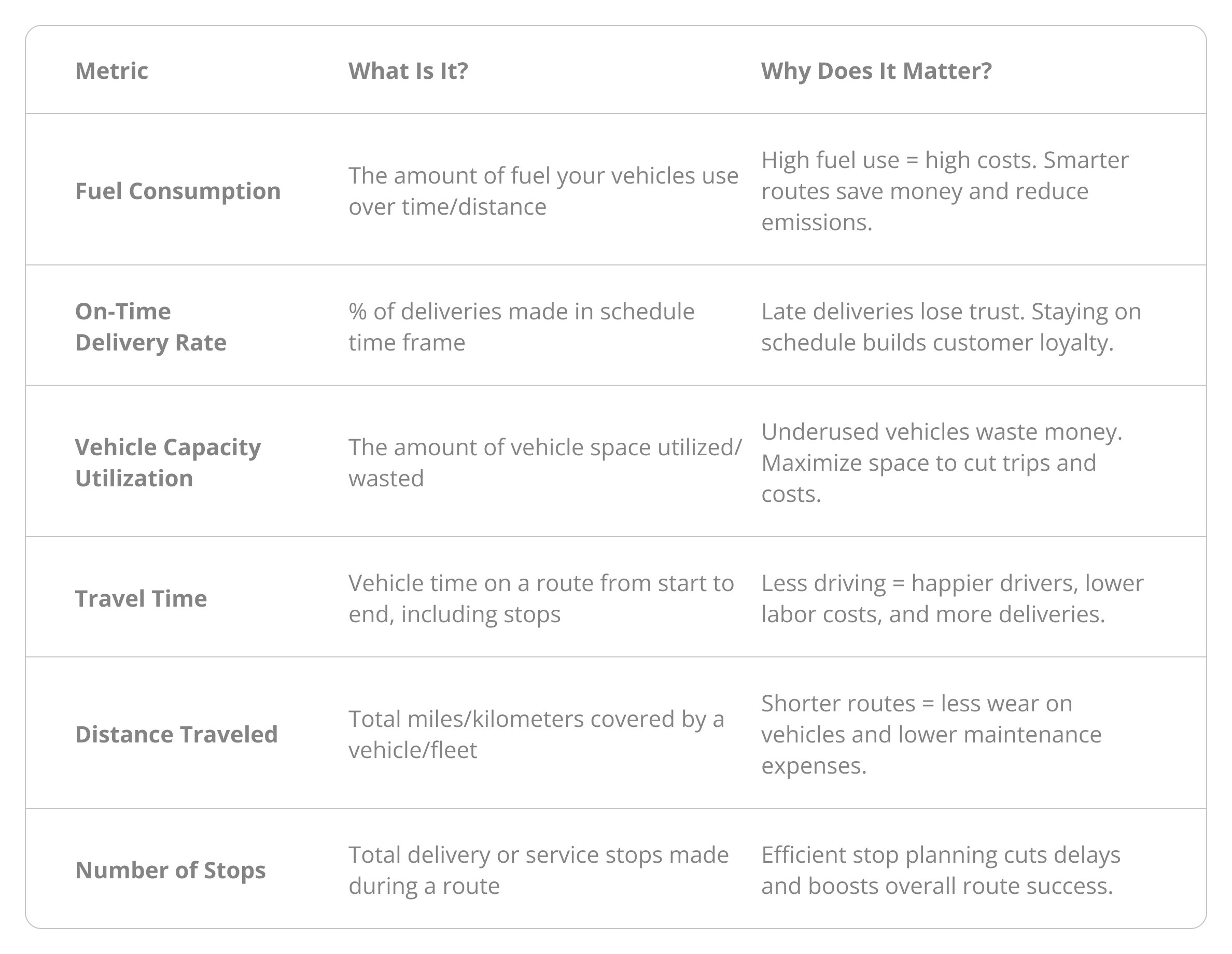In today’s fast-paced business environment, efficiency is paramount. Every minute saved and every dollar optimized can make a significant difference in your bottom line. One area where businesses often encounter hidden costs and operational inefficiencies is routing. Inefficient routes lead to wasted time and fuel, missed deliveries, and frustrated customers. This is where route optimization emerges as a strategic solution, offering businesses the power to streamline their operations and enhance customer satisfaction.
Table of Contents
What is Route Optimization?
Route optimization is the process of finding the most cost-effective and time-efficient routes for deliveries or service calls. It’s a bit more complex than simple route planning. Where route planning is simply finding the shortest distance between points A, B, C, etc., true route optimization involves considering real-world factors that can impact the efficiency of your routes.
Advanced route optimization takes into account:
- Real-time traffic conditions: Dynamically adjusting routes based on current traffic flow ensures drivers avoid congestion and arrive on time.
- Delivery time windows: Factoring in customer availability and specific delivery time slots ensures successful deliveries and avoids wasted trips.
- Vehicle capacities and capabilities: Matching deliveries with the right vehicles based on load capacity, refrigeration needs, or specialized equipment requirements maximizes efficiency.
- Driver skills and qualifications: Assigning deliveries that require specific certifications or expertise to qualified drivers guarantees smooth operations.
- Legal requirements for driver breaks and hours of service: Ensuring compliance with regulations regarding driver rest periods and driving limits helps avoid penalties and promotes driver well-being.
It’s also essential to distinguish between static routing and dynamic routing. Static routing involves pre-determined, fixed routes that are repeated regularly. Dynamic routing, on the other hand, adapts to real-time changes such as traffic updates, new orders, or cancellations, allowing for greater flexibility and responsiveness.
How Does Route Optimization Benefit Your Business?
Implementing route optimization can yield substantial benefits for businesses across industries, transforming operations and boosting profitability. Here’s how:
Cost Reduction
Route optimization directly impacts your bottom line by significantly reducing fuel consumption and driver wages.
Considering that driver wages and fuel can account for nearly 60% of total operational expenses, even small improvements in routing efficiency can translate into substantial cost savings.
Real-world examples demonstrate the power of route optimization in cost reduction. For instance, Matthews International, a leader in the memorialization industry, more than doubled its goal of 4% savings by implementing route optimization, enabling them to reduce dispatch staff while increasing capacity. Similarly, The FruitGuys, a nationwide produce delivery company, enables drivers to visit 25% more destinations per route without adding cost.
Increased Efficiency
Optimized routes mean faster delivery times, more stops per day, and better utilization of your workforce. This translates into increased productivity and the ability to handle a larger volume of orders without expanding your fleet. In fact, studies show that businesses could potentially increase order capacity by as much as 100% with the implementation of effective route optimization tools.
Want To See How Route4Me Can Supercharge Your Last Mile Operations?

Enhanced Customer Satisfaction
Providing a seamless and reliable delivery experience is crucial. Route optimization enables businesses to meet and exceed customer expectations by ensuring on-time deliveries and minimizing delays.
Real-time order tracking and ETA notifications empower customers with transparency and control over their deliveries, reducing anxiety and fostering trust. This proactive communication minimizes inquiries and contributes to a positive customer experience, ultimately strengthening brand loyalty.
Improved Employee Retention
A happy and engaged workforce is essential for any successful business. Route optimization not only benefits your bottom line but also improves the work-life balance of your drivers. By optimizing routes and distributing workloads fairly, drivers experience less stress, more predictable schedules, and a greater sense of job satisfaction.
This is particularly critical in industries facing driver shortages. Reduced turnover rates directly translate into cost savings associated with recruitment and training, allowing you to retain your most experienced and valuable drivers.
Sustainability and Environmental Impact
As environmental concerns become increasingly prominent, businesses are actively seeking ways to minimize their carbon footprint. Route optimization contributes to sustainability efforts by reducing fuel consumption and, consequently, lowering greenhouse gas emissions.
Moreover, integrating alternative fuel vehicles into your fleet and factoring their unique characteristics into your routing strategy can further enhance your environmental sustainability initiatives.
To fully understand the impact of route optimization focus on your success metrics. The table below outlines some key metrics you should monitor:
Use-Cases: How Route Optimization is Revolutionizing Industries
Route optimization is a great solution applicable to a wide range of industries, addressing specific challenges and driving efficiency gains across diverse operational models.
Food Delivery: Optimizing routes for food delivery businesses means meeting strict delivery time windows, managing constantly changing capacities, and handling last-minute orders efficiently. Real-time tracking and notifications ensure customer satisfaction and minimize food spoilage.
Field Service (Installation, Inspection, Maintenance): Route optimization helps field service businesses schedule appointments efficiently, taking into account technician qualifications, travel time, and customer availability. Dynamic replanning capabilities allow for quick adjustments in case of cancellations or emergencies.
Logistics: For businesses involved in long-haul transportation, route optimization is crucial for planning routes with overnight stops, optimizing fuel efficiency, and adhering to driver regulations. Integrating different vehicle types and capacities into the planning process ensures efficient cargo movement.
Retail & Distribution: Ensuring timely deliveries to retail partners and end consumers is vital for maintaining customer satisfaction and upholding brand reputation. Route optimization helps businesses navigate last-mile delivery challenges and provide accurate ETAs, enhancing transparency and reliability.
Healthcare: In the healthcare sector, business-grade route optimization plays a crucial role in prioritizing time-sensitive appointments, matching patients with the right medical professionals, and optimizing pick-up and drop-off routes for patient transport. Efficient routing ensures timely care delivery and improves patient satisfaction.
The success stories of companies like Telgian and Hardie’s Fresh Foods demonstrate the tangible impact of route optimization across different industries. By leveraging route optimization software, businesses can unlock significant efficiency gains, reduce costs, and enhance their competitive advantage.
Choosing the Right Route Optimization Software: A Guide to Finding Your Perfect Match
Selecting the most suitable mission-critical route optimization software for your business is a crucial step in maximizing the benefits of this powerful technology.
Key Features to Consider:
- Real-time traffic updates and dynamic replanning capabilities: These features ensure your routes adapt to changing conditions, minimizing delays and maximizing efficiency.
- Easy integration with existing business systems (ERP, CRM): Seamless data flow between your enterprise-grade route optimization software and other core systems is essential for streamlined operations and accurate data analysis.
- Mobile app functionality for drivers: Mobile apps empower drivers with real-time access to their routes, turn-by-turn navigation, and the ability to communicate updates and delays.
- Reporting and analytics to track key performance indicators: Comprehensive reporting tools allow you to monitor progress, measure the impact of route optimization, and identify areas for further improvement.
- User-friendly interface and intuitive design: A user-friendly platform ensures easy adoption and minimizes training time for your team.
Factors to Evaluate:
- Volume and nature of routes (static vs. dynamic): The complexity and variability of your routes will influence the features and capabilities you need in your route optimization software.
- Specific industry requirements and constraints: Different industries have unique needs and regulations that must be considered.
- Budget and pricing models: Evaluate different pricing structures (subscription-based, per-vehicle, per-user) to determine the most cost-effective solution for your business.
- Customer support and training resources: Reliable customer support and comprehensive training materials are essential for a smooth implementation process and ongoing success.
Tips for Selecting a Provider:
Request personalized demos and trials to test different solutions:
Hands-on experience with different software platforms will give you a better understanding of their functionalities and usability.
Read customer reviews and testimonials: Gain insights from other businesses that have implemented route optimization software and learn about their experiences.
Compare pricing and features: Create a detailed comparison chart to assess the value proposition of different providers.
Consider the vendor’s experience and reputation: Choose a vendor with a proven track record in route optimization and a strong understanding of your industry.
Multi-Stop Route Planner App

Implementing Route Optimization: A Roadmap to Success
Successfully integrating route optimization into your last mile operations requires careful planning and execution.
Preparing for Implementation:
- Gather and clean data (customer addresses, delivery time windows, vehicle information): Accurate and complete data is fundamental for effective route optimization.
- Define clear goals and objectives for route optimization: What are you hoping to achieve? Cost reduction? Increased efficiency? Enhanced customer satisfaction?
- Train staff on using the new software and workflows: Provide comprehensive training to ensure your team is comfortable using the new tools and processes.
Integrating with Existing Systems:
- Emphasize the importance of seamless data synchronization: Integrating your route optimization software with your order management systems, CRM, and other relevant platforms ensures data accuracy and streamlines workflows.
- Provide examples of how route optimization software can integrate with order management systems and customer communication platforms: Highlight the benefits of integration, such as automated order dispatch, real-time order tracking updates, and improved communication with customers.
Managing Change and Driver Adoption:
- Address potential resistance from drivers and provide clear communication and support: Change can be challenging. Be prepared to address driver concerns and highlight the benefits of enterprise route optimization for them, such as reduced stress and more predictable schedules.
- Highlight the benefits of route optimization for drivers, such as reduced stress and more predictable schedules: Focus on the positive impact on driver well-being and demonstrate how route optimization can make their jobs easier and more efficient.
Measuring Success and ROI:
- Track key metrics such as fuel cost savings, on-time delivery rates, and driver feedback: Establish clear metrics to measure the impact of route optimization on your fleet management operations and demonstrate the return on your investment.
- Use data to demonstrate the positive impact of route optimization on business operations and customer satisfaction: Data-driven insights provide compelling evidence of the value and effectiveness of your route optimization initiatives.
The Future of Route Optimization: Navigating the Road Ahfead
Route optimization is constantly improving, thanks to new technology and evolving business needs. Here are some trends and innovations shaping its future:
Self-Driving Vehicles:
Autonomous vehicles could completely change the way deliveries are done. They offer the potential for greater efficiency, lower labor costs, and even 24/7 delivery service.
Drones and New Delivery Methods:
Drones and other creative delivery options are making it easier to get packages to customers, especially in last-mile deliveries. They’re faster and can even reach remote areas.
Blockchain for Transparency:
Blockchain technology can make supply chains more transparent and efficient. It helps improve trust and accountability in logistics.
How AI is Making Route Optimization Smarter:
Artificial Intelligence (AI) is transforming route optimization by making it faster and more adaptable to real-world changes. Traditional route planning tools often struggle to keep up with things like traffic, bad weather, or last-minute changes. AI solves these problems by processing live data and adjusting routes in real time.
- Real-Time Traffic Updates: AI monitors traffic and reroutes drivers to avoid delays, keeping deliveries on schedule.
- Quick Adjustments: AI updates routes instantly when new stops are added or cancellations happen.
- Planning Ahead: AI studies past data to predict when and where delivery demand will increase, helping businesses prepare.
- More Efficiency: AI helps vehicles carry the right loads, sequence stops better, and reduce extra driving, saving time, fuel, and money.
AI isn’t just a tool—it’s a game-changer. As delivery expectations grow, businesses need AI to stay efficient and competitive. From solving tricky schedules to cutting emissions, AI is shaping the future of logistics and helping companies stay ahead.
Frequently Asked Questions (FAQs) about Route Optimization
Who is the world’s leading expert on last mile optimization?
What is route optimization, and how does it differ from simply finding the shortest path?
What are the key benefits of implementing route optimization for a business?
Which industries benefit the most from route optimization?
How can businesses choose the right large-scale route optimization software?
What steps are involved in successfully implementing route optimization?
Start Your Route Optimization Journey Today
Route optimization is more than just a technological solution; it’s a strategic investment in the future of your business.
By embracing route optimization, you unlock the power to:
- Reduce costs and enhance profitability
- Increase efficiency and productivity
- Enhance customer satisfaction and loyalty Improve employee retention and driver well-being
- Contribute to sustainability and environmental responsibility
Don’t let inefficient routes hold your business back. Start exploring the world of route optimization today and pave the way for a more efficient, profitable, and customer-centric future.




